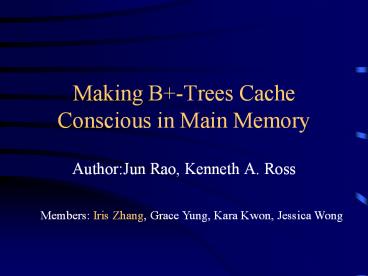Making B -Trees Cache Conscious in Main Memory - PowerPoint PPT Presentation
Title:
Making B -Trees Cache Conscious in Main Memory
Description:
Making B+-Trees Cache Conscious in Main Memory Author:Jun Rao, Kenneth A. Ross Members: Iris Zhang, Grace Yung, Kara Kwon, Jessica Wong Outline 1. – PowerPoint PPT presentation
Number of Views:209
Avg rating:3.0/5.0
Title: Making B -Trees Cache Conscious in Main Memory
1
Making B-Trees Cache Conscious in Main Memory
- AuthorJun Rao, Kenneth A. Ross
Members Iris Zhang, Grace Yung, Kara Kwon,
Jessica Wong
2
Outline
- 1. Introduction
- 2. Related Work
- 3. Cache Sensitive B-Trees
- 4. Conclusion
3
Motivation
- Significant portion of execution time
- second level data cache misses
- first level instruction cache misses
System Hierarchy
4
Motivation (Contd)
- 2. CPU speeds have been increasing at a much
faster rate than memory speeds
- Conclusion improving cache behavior is going to
be an imperative task in main memory data
processing - Resolution using memory index structure
5
Cache Memories
Cache memories are small fast static RAM memories
that improve performance by holding recently
referenced data.
- Parameter
- Capacity
- Block Size (cache line)
- Associativity
- Memory reference
- Hit
- Miss
6
Cache Optimization on Index StructuresB-Trees
- Height-balanced tree
- Minimum 50 occupancy (except for root). Each
node contains d lt m lt 2d entries. The
parameter d is called the order of the tree.
(n2d) - Each node is 1 cache line (cache-line based)
- Full pointer
B-Tree (n 2)
7
Cache Optimization on Index StructuresCSS-Trees
- Similar as B-tree
- Eliminating child pointers
- Storing child nodes in a fixed sized array.
- Nodes are numbered stored level by level, left
to right. - Position of child node can be calculated via
arithmetic. - No pointer
CSS-Tree
8
Comparison between B-Trees and CSS-Trees
- Cache Line Size12 bytes, Key SizePointer Size4
bytes - Search key 3
- B-Tree CSS-Tree
9
Comparison between B-Trees and CSS-Trees(contd)
- B tree
- full pointer
- more cache access and more cache misses
- efficient for updating operation, e.g. insertion
and deletion
- CSS tree
- no pointer
- fewer cache access and fewer cache misses
- acceptable for static data updated in batches
Conclusion partial pointer elimination
10
Cache Sensitive B-Trees
- Cache Sensitive B-Trees with One Child Pointer
- Segmented CSB-Trees
- Full CSB-Trees
11
Cache Sensitive B-Trees with One Pointer
- Similar as B-tree
- All the child nodes of any given node are put
into a node group with one pointer - Nodes within a node group are stored continuously
and can be accessed using an offset to the first
node in the group
12
Cache Sensitive B-Trees with One Pointer (contd)
- Cache misses are reduced because a cache line can
hold more keys than B-Trees and can satisfy one
more level comparison. - CSB-Tree can support incremental updates in a
way similar to B-Tree
Cache Line Size64 bytes, Key SizePointer Size4
bytes B-Tree 7 keys per node CSB-Tree 14 keys
per node
13
Operations on CSB-TreeBulkload
14
Operations on CSB-Tree Insertion
- Search the leaf node n to insert the new entry
- If n is not full, insert the new entry in the
appropriate place - Otherwise, split n. Let p be n parent node, f be
the first-child pointer in p and g be the
node-group pointed by f - If p is not full, copy g to g' in which n is
split in two nodes. Let f point to g' - If p is full, copy half g to g'. Let f point to
g'. Split the node-group of p according to step a
15
Operations on CSB-Tree Insertion (contd)
22
key 34
23 57 1213 1619 2022 2425 2730
3133 3639
a CSB-Tree of Order 1
16
Operations on CSB-Tree Insertion (contd)
22
key 34
25 3336
23 57 1213 1619 2022 2425 2730
3133 3436 39
17
Operations on CSB-TreeSearch
- Determine the rightmost key K in the node that is
smaller than the search key - Get the address of the child node
- Goto first step until find the search key or
there is no other node can be checked - Search method in a node
- basic approach uniform approach variable
approach
18
Segmented Cache Sensitive B-Trees
- Problem its time consuming to split a node
group - ResolutionSCSB-Tree
- method divide node group into two segments with
one child pointer per segment - result better split performance, but worse search
19
Full CSB-Tree
- Motivation reduce the split cost
- Method
- pre-allocate space for a full node group
- shift part of the node group along by one node
when a node split - Result
- reduce the split cost, but increase the space
complexity
20
Conclusion
- CSB-Trees are more cache conscious than B-Tree
because of partial pointer elimination - CSB-Trees support efficient incremental updates,
but CSS-Trees do not - Partial pointer elimination is a general
technique which can be applied to other memory
structures































